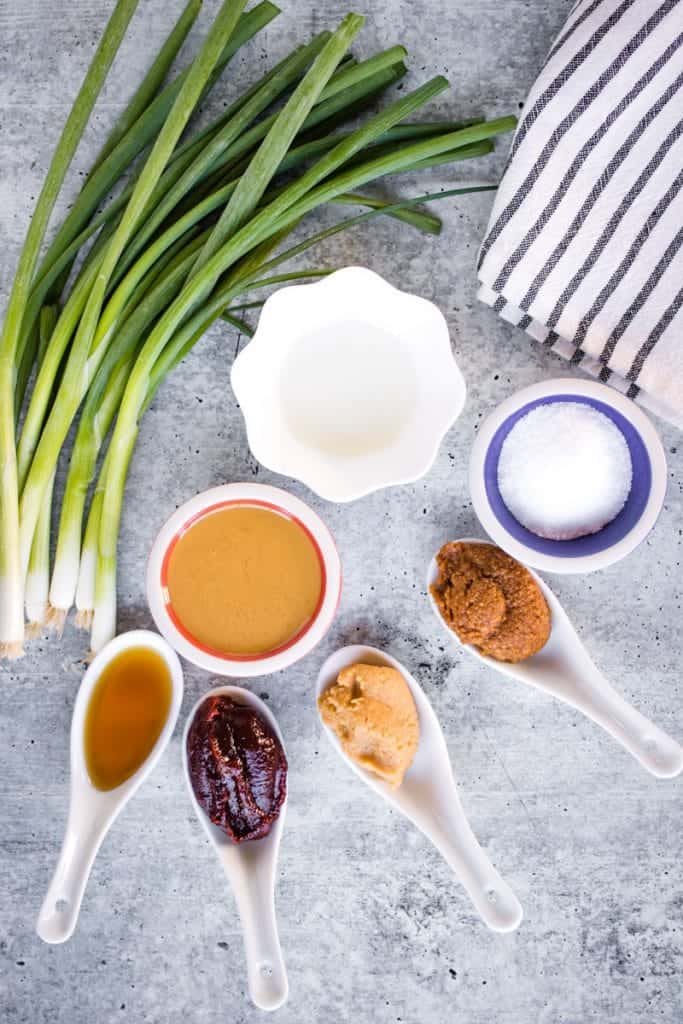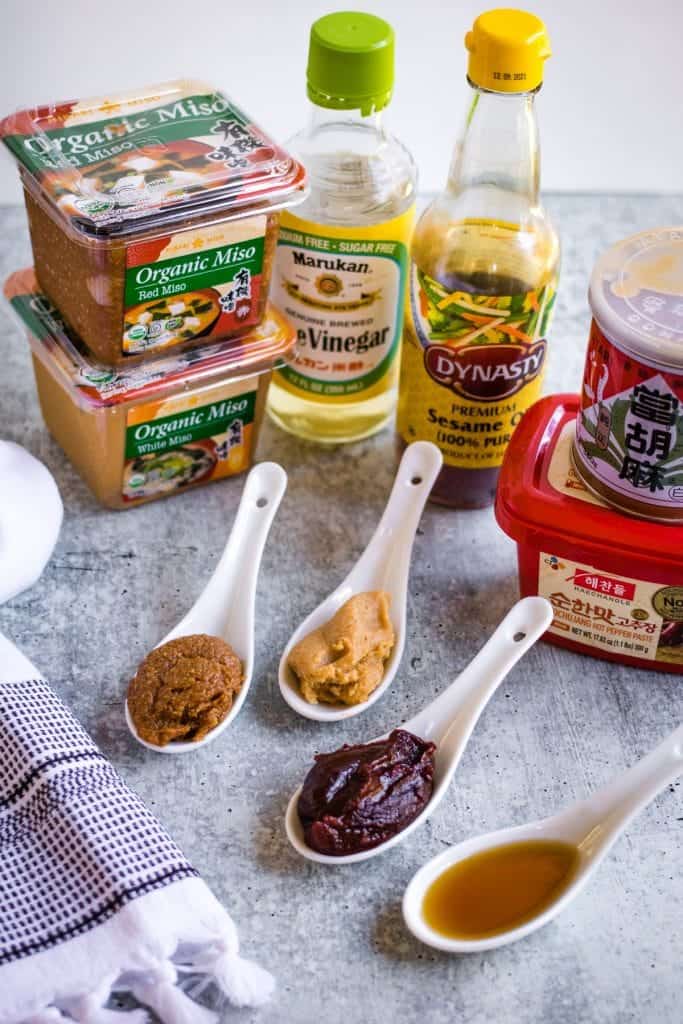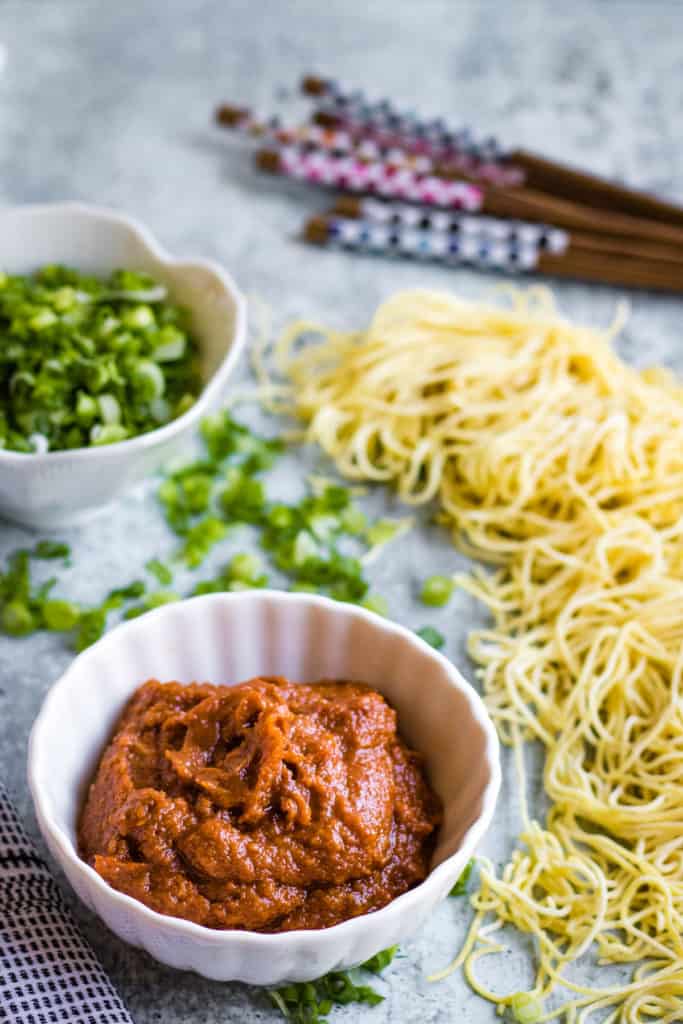Ramen tare is the “secret sauce” that ramen cooks put at the bottom of your bowl before adding noodles, broth, and toppings. It is the magic that gives a bowl of ramen such deep, complex flavor.
This post may contain affiliate links. As an Amazon Associate, I earn from qualifying purchases. See my Affiliate Disclosure.

Spicy Miso Ramen Tare is a spicy version of miso tare that gives a bowl of ramen its base of umami and flavor. Tare is one of the most essential parts of a good bowl of ramen.
I use keep a tub of this tare in my refrigerator at all times so that we can whip up a delicious ramen any time. Try it in my Spicy Miso Ramen with Chicken Karaage, Sauteed Kale, and Soft Boiled Egg.
How is homemade ramen different from instant ramen?
If you grew up, like I did, eating instant ramen out of a square package, you’ve probably been happy to learn about the nuances of a bowl of restaurant or food truck ramen.
It turns out, ramen can be so much more than quick-cooking noodles, water, and powdered seasoning.
In fact, a good bowl of hand-crafted ramen includes four elements:
- Broth (usually a simple broth made from bones, dried fish, dried seaweed, and/or dried mushrooms and water with little seasoning)
- Ramen noodles (wheat noodles alkalinized with kansui to give them their distinctive chewy texture)
- Toppings (everything from soft-boiled eggs to fried chicken, roasted vegetables, and even cheese)
- Ramen tare, the seasoning mixture that gives the bowl of ramen broth its depth of flavor

What is ramen tare?
The word “tare” is Japanese for “sauce.” In ramen recipes, it refers to a concentrated seasoning mixture that is placed in the serving bowl before the noodles, broth, and toppings are added.
Ramen tare is what gives a bowl of ramen its deep, rich, distinctive flavor. Each ramen shop and chef has their own secret tare recipes, and those recipes are closely guarded.
There’s a famous ramen restaurant chain called Ichiran that is famous for their spicy red tare, which, legend has it, is known by only four people in the world. And those four people are not allowed to travel on the same plane together. That’s how tightly held some tare recipes are!
What are the different types of ramen tare?
Making your own ramen tare is easy and it means you can make your own delicious ramen at home.
There are three primary types of tare for ramen:
Shoyu (soy sauce based) Shoyu means soy sauce. This is the oldest and most traditional tare. It provides the concentrated flavor for shoyu ramen. It can be a simple blend of soy sauce, sake, and mirin, or it may include a dozen ingredients like kombu, chili peppers, and bonito flakes.
Shio (salt based) Shio tares start with a base of salt (shio means salt). Shio tare is sometimes made of just water, salt, and sake. It can also have a complex layering of ingredients like kombu (dried kelp), shiitake mushrooms, dried sardines, dried anchovies, sugar, mirin, sake, and bonito flakes (dried fish flakes).
Miso Made from a base of miso—a salty paste made from fermented soybeans and other grains. Miso tare usually combines miso paste with other ingredients like mirin, sake, ginger, sesame paste, and soy sauce. You can also use a miso paste substitute.
Spicy miso tare is a variation of miso tare and it is my personal favorite. The recipe below is for Spicy Miso Ramen Tare from my new cookbook Ramen for Beginners.
Spicy Miso Tare includes a spicy element like Korean gochujang, the fermented chile and soybean paste that is full of umami. If you don't have gochujang, use chile paste, like sambal oelek, which is widely available in Asian groceries and most supermarkets.
My spicy miso tare also has a rich backdrop of toasted sesame flavor from both sesame oil and Japanese sesame paste. If you can’t find Japanese sesame paste, you can substitute smooth, all-natural (no sugar added) peanut butter.

What ingredients do you need to make spicy miso tare?
You can find all of these ingredients in Japanese and Asian grocery stores. Even your local grocery store likely carries many of the key ingredients like soy sauce, mirin, and miso paste. Try to buy Japanese brands, if possible. You can also order ingredients online if you can’t find what you need locally.
- Miso paste
- Salt
- Japanese sesame paste
- Toasted sesame oil
- Rice vinegar
- Gochujang or chile paste
What is miso paste and which type do you use in miso tare for ramen?
Miso paste is a paste of soybeans fermented with rice and other grains. It adds deep, rich salty umami flavor to miso soup, ramen tare, and many other Japanese dishes.
Want to save this recipe?
I like to use half white miso paste, also called shiro miso, which is light in color and mild in flavor, and half red miso paste, also called aka miso, which is dark in color and has a stronger, more intense flavor.
You can also buy awase miso paste, which is a combination of red and white. I like to have both red and white on hand for different recipes, so I combine the two. If you prefer to buy just one miso paste to make miso tare, the awase type is perfect.
What is Japanese sesame paste?
Japanese sesame paste, called neri goma in Japanese, is a thick paste of ground sesame seeds that have been roasted to a deep brown color. The resulting paste has a deep, toasted, nutty flavor. Japanese chefs use it in dishes like gomae, a Japanese dish of cooked spinach in a rich sesame sauce, or in Japanese sesame salad dressings or dipping sauces.
Chinese sesame paste is very similar to the Japanese version and makes a fine substitute.

What can I substitute for Japanese sesame paste?
If you don’t have Japanese sesame paste, your first thought may be to substitute tahini. Isn’t tahini also a sesame paste? It is, but unlike neri goma, tahini uses raw or very lightly toasted sesame seeds, grinding them to a paste. The flavor is much less intensely nutty and it lacks the rich toastiness.
A better substitute for Japanese sesame paste is smooth, all-natural, no-sugar-added peanut butter. It has the same pronounced nuttiness and rich toasted flavor. It also has the advantage of being easy to find in any supermarket and is inexpensive.
What is gochujang?
Gochujang is what gives this miso tare its spicy kick. It also adds even more umami.
Gochujang is a paste of fermented hot chiles, rice, soybeans, and salt. It’s thick, deep red, and can be very spicy. It is also full of intense umami and a hint of sweetness.
I buy my gochujang at a local Korean market or large Asian supermarket like Ranch 99. You can also buy gochujang online. (If you live in the Bay Area, check out Koreana Plaza in Oakland for a great Korean market experience!)
A tub of gochujang will keep for a long time in the refrigerator, so buy a good-sized tub of it.
You can also use gochujang to make my Korean Fried Chicken and other scrumptious Korean dishes.
If you don't have gochujang, substitute Asian chile paste like sambal oelek, also available in Asian grocery stores and most supermarkets.
How to use ramen tare
In my book Ramen for Beginners, you'll find lots of ways to use ramen tare. This recipe is there, and there are also recipes for non-spicy Miso Tare, Shoyu Tare, Shio Tare, and Shiitake Dashi (vegan).
To use this tare, see my recipe for Spicy Miso Ramen with Chicken Karaage. Or use it with any combination you like of broth, noodles, and toppings.
Just add 2 tablespoons of the tare to your soup bowl before pouring in the hot broth. Stir to combine and then add your noodles and toppings.
How long can I keep spicy miso tare?
Tare will keep for at least a few weeks in your refrigerator, You can also use it to flavor a stir-fry sauce or dipping sauce for dumplings. In Japanese, “tare” actually means “dipping sauce.”
This spicy miso tare will keep in a covered container in the refrigerator for up to 2 months.

more japanese recipes you'll love
- Yaki Onigiri
- Chicken Karaage
- Spicy Miso Ramen
- Ramen Tare
- Soy Sauce Eggs
- Sunomono
- Onigiri
- Miso Salmon
- Stir-Fried Lotus Root
- Chawanmushi
- Japanese Souffle Pancakes


Spicy Miso Tare for Ramen
Robin Donovan
Ingredients
- 1/2 cup miso paste use 1/4 cup white miso paste and 1/4 cup red miso paste or 1/2 cup awase miso paste
- 1/4 cup kosher salt
- 1/4 cup water
- 3 tablespoons Japanese sesame paste
- 1/4 cup gochujang or chile paste like sambal oelek
- 2 tablespoons sesame oil
- 1 tablespoon rice vinegar
Instructions
- Combine the miso paste, salt, water, sesame paste, gochujang, sesame oil, and rice vinegar together in a small bowl and mix to a paste.
- Use to season bowls of hot ramen broth.




How do I use this? Do I boil it with the broth the. Add the noodles? Or put a chunk in the bowl then the noodles? Thank you!
Add it to the bowl first and then pour the broth over, add noodles and topings next.
The recipe doesn’t list Gochujang as an ingredient. How much should be used?
Thank you for letting me know! I have fixed it. 1/4 cup gochujang!
Is 1/4 cup salt accurate? That’s seems a bit crazy.
It is correct. Remember you are using the paste as a seasoning condiment. You’re not going to be eating spoonfuls of it!
Thank you
How much of the tare should you add to a normal size bowl of ramen? A tablespoon or two?
It really depends how large your bowl is. A typical ramen bowl is anywhere from 34 to 58 ounces. Use 2 tablespoons for an average size bowl, which would be around 46 ounces. If your bowls are much larger or much smaller, you’ll want to adjust the amount.
Thanks, did 2 tablespoons tonight with 2 tablespoons of dashi ( maybe more dashi?) and it was very good. Regarding your nutritional information sign, how large is your serving size?
If we cannot find Japanese sesame paste, you recommend peanut butter. Could we not just use tahini (non Japanese sesame paste)? It is widely available for making hummus and other middle eastern dishes. Thanks!
Hi Kat! That is a great question. I don’t generally recommend tahini as a substitute for Japanese sesame paste because both the flavor and texture are different. Japanese sesame paste is made with dark-roasted sesame seeds. The flavor is very nutty-toasty and the texture is creamy. Tahini is made with either untoasted or lightly toasted sesame seeds, so the flavor is not as deeply nutty and toasty and the texture is drier. I love tahini and use it frequently in Middle Eastern cuisines, but all-natural creamy peanut butter (with no sugar added) is a better substitute for Japanese sesame paste.
Awesome recipe, and it’s really great that you respond to people’s questions!
I have two that I hope you can answer:
Do you cook this at all?
and
Am I right in assuming the broth used shouldn’t contain any soy sauce, as the seasoning is coming from the tare?
YOu do not need to cook this tare before adding it to the soup bowl. And you are correct, the broth shouldn’t contain any soy sauce or other seasonings. This is the traditional Japanese way to make broth for ramen soup–the seasonings are added separately.
What other uses does this have? Just made it 2 days ago for my first Ramen and I don’t know…
I don’t know if there are other uses for it! As far as I know, tare is made as the flavor base for ramen.
Very good recipe.
I actually bought your book.
I did everything exactly as you told and it turned out great.
Not really a gripe, but a point I’m curious about you mentioning peanut butter as a substitute for sesame paste.
I haven’t tried with PB yet but do you notice a taste difference?
I tasted both foods alone and to my taste they are indeed very similar. Sesame paste has more natural oil if anything.
It’s funny cause I can pay 2x or 3x for good sesame paste or just get a big tub of peanut butter and still pay less 🤣
That’s awesome. Thank you for buying my book!
The taste is a bit different, but it’s still good. Sesame paste is much more authentic, but if you don’t have it or don’t want to spend so much on it, I personally think that the peanut butter version is just as good. Make sure you use the all-natural peanut butter that doesn’t have sugar or other stuff added (salt is okay but since this is already salty, unsalted would be fine, too).
No, it’s 2 tablespoons tare for each bowl of soup–so that is 2 cups of broth plus noodles, etc, and 2 tablespoons tare. The Spicy Miso Ramen recipe calls for 8 cups of broth and 1/2 cup of tare–so that’s 2 tablespoons of tare for each bowl of ramen which contains 2 cups of broth (plus noodles, etc.) I don’t know where you are seeing 1/2 cup of tare to 1 cup of water.
I’m sorry you misunderstood the instructions. The tare is made with 1/2 cup of salt, but that is for numerous servings of ramen. You only use 2 tablespoons of the tare in a serving of ramen, which uses 2 cups of broth. So it is 1 tablespoon of tare to 1 cup of broth.
I loved this recipe. Like others though, I thought that the salt was too much. 2 tablespoon of tare in 2 cups of broth makes it very salty. Any idea on how I can make this broth not so salty? I think it needs more sugar or something. Thank you.
Angela
Angela,
Just being creative here but if a recipe is too salty for your taste preferences might try reducing the amount of salt. 😉
Hey, I was thinking about making this and I happen to have Chinese fermented black bean paste in my fridge, but I don’t have sesame paste. What do you think about potentially using black bean paste as a sub for sesame paste here?
I think the flavor would be very different–black bean paste is much saltier/funkier than sesame paste. I would substitute regular no-sugar-added peanut butter for the sesame paste. You could also substitute tahini and some toasted sesame oil, but the flavor won’t be as nutty.
How long is the tare good for? I assume I would store it in the fridge. Thanks!
You can store it in the fridge for at least 5 days.